We all have a friend or family member that just doesn’t like to play board games. Getting them to sit down and play is like pulling teeth. Sometimes you can get them to play and other times they just won’t do it. Unfortunately, there is no magic pill you can give them that get them to do what you want…not a legal one anyway.
After years of trying to get reluctant loved ones to play board games with us, we have identified several games that make a more compelling argument to these people. These games tend to be easier to convince people to play when they’d normally rather sit out. Obviously, it isn’t an exact science because everyone has different preferences, but this will get you in the right vicinity when you make your pitch.
What are the best 11 board games that are great to play with non-gamer friends?
- Qwirkle
- Bananagrams
- Codenames
- Big Money
- Just One
- Boggle
- Wits and Wagers
- Chameleon
- Double Ditto
- One Night: Ultimate Werewolf
- Telestrations
Each of these games is great. You wouldn’t go wrong just picking one off the list and going for it, but not every game fits every group. Some are better for very large, party groups, while others are better suited to only a few players. For a full list of all the games we recommend, take a look at our resources page. You can support us through clicking our links on it.
1) Qwirkle
Specifications
| Players | Duration | Age | Type | Difficulty | Price |
| 2-4 | 45 minutes | 6+ | Abstract | Easy | $20-$25 |
How it plays
Qwirkle starts us off with a very simple game—though most games on this list fit into the simple category. Qwirkle is all about matching. Each player holds 6 tiles in front of them that they use to play. The tiles have various colors and shapes on them. Players take turns matching the shapes and colors with the ones already in the middle of the board. They can score various point values depending one where they place their tiles and what they’re next to. The game ends when there are no more moves or no more tiles left in the game. The player with the highest score at this point wins.
Why it’s good for non-game players
Qwirkle is almost more of a puzzle than it is a game. Yes, it is obviously an interactive game, but players are just trying to place their tiles into the middle in creative ways. Lots of people that don’t really care for board games, still love “puzzles” that make them think as they play. Qwirkle is the perfect game for these types.
In unison with the fact that it’s almost as much of a puzzle as it is a game, is that it’s extremely easy to play. So it’s a puzzle that makes you think, but you don’t spend your time thinking about how the game itself works. You can spend your time actually thinking about what your best moves are and where to play. This can make it much easier to get someone to play with you that normally wouldn’t like playing.
2) Bananagrams

Specifications
| Players | Duration | Age | Type | Difficulty | Price |
| 1-8+ | 15-20 minutes | 7+ | Word | Very easy | $15 |
How it plays
Bananagrams is a word game where players take a specific number of tiles (each with a random letter on it) depending on the number of players. On go, players flip their tiles and begin connecting them together to make crossword-like webs of words. The first player to connect all letters shouts “peel”, which forces all players to take another tile from the communal pile in the middle. Now each player must figure out how to work that letter into the web of words. Once a player connects all letters, he or she shouts “peel”. This process continues until one player uses all tiles—and no more tiles are left in the middle. That player wins!
Why it’s good for non-game players
Bananagrams is a game that, admittedly, I avoided for a while. In fact, for years, when I saw others playing it, I went the other direction. When people asked if I wanted to play, I declined and waited for the next game to be brought out. Finally, when on Christmas break one year, a few family members made me sit down at the table and play “just one round”; from which, I didn’t get up until I had played more than 10 rounds. I loved it!
This game is incredibly simple to learn how to play and very easy during gameplay. There really isn’t anything to learn beyond connecting the words together and drawing another tile when someone says “peel”. Obviously, it isn’t quite that simple; but almost. For those that just don’t like playing games because they don’t want to learn a new game—this is the perfect game to pull out. It’s quick learning and it’s really fun! Even though it may not look fun from the outside (I’m the perfect example of this), it is extremely fun once you start playing.
3) Codenames
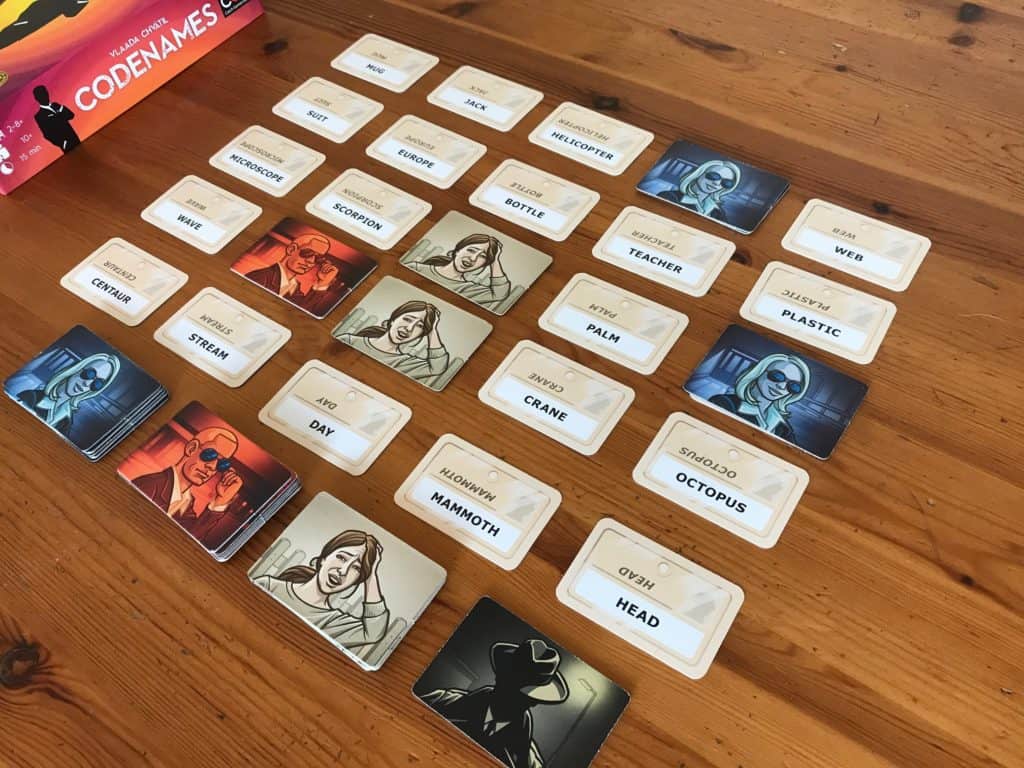
Specifications
| Players | Duration | Age | Type | Difficulty | Price |
| 2-8+ | 20-30 minutes | 14+ | Word | Easy | $15-$20 |
How it plays
As the second of four word games on this list, Codenames is another great one! Players are divided into two teams. Each team has a lead player that will give clues. On the table there are 25 cards (5×5 grid), each with one word on it. Lead players have a key to know which words are assigned to their own team, which words are assigned to the other team, which words aren’t assigned to either team and which word (if chosen) automatically loses the game. Lead players then take turns giving one-word clues to get their teammates to guess their assigned words. The more words a team can guess in one round the better because the first team to guess all of their assigned words wins.
Why it’s good for non-game players
One of the most compelling reasons that Codenames is great to play with friends and family that don’t usually play is that they aren’t playing alone. In other words, they will probably like it more because they are on a team with several others. They don’t have to play their own turns and figure out every nuance of the game. They can rely on those that have played before and are already familiar with the game.
A very closely related reason to play Codenames is that new players don’t have to be focused 100% of the time. If you have family members that don’t like playing because they have to sit and study the game board for an hour to make sure they don’t miss something, this is the perfect game for them. They could completely zone out for half the game and it wouldn’t ruin it (though it would still present some challenges). Other players could quickly fill teammates in.
Yet another great reason to pull out Codenames is that it gets a big group together. Codenames technically recommends “2-8+” players and the “+” is important. Because of how it plays, Codenames could play with a dozen or more players—as long as there is room around the table. That combined with the previous two reasons makes this a great, fun game for people that don’t traditionally like playing.
4) Big Money
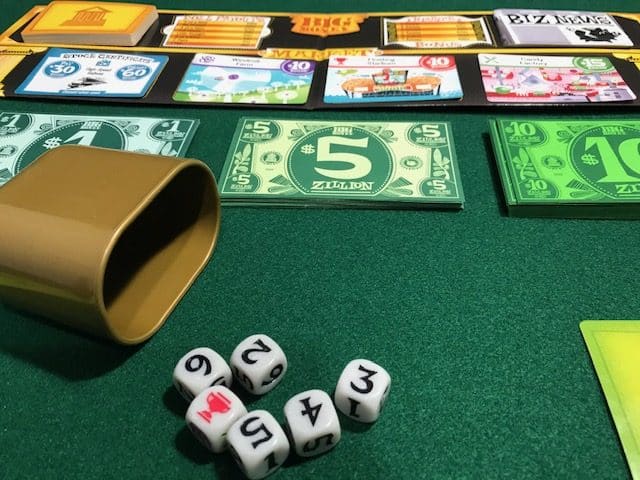
Specifications
| Players | Duration | Age | Type | Difficulty | Price |
| 2-5 | 30 minutes | 8+ | Dice, Economic | Easy | $15 |
How it plays
The easiest way to describe the essence of Big Money is to say that it is a combination of Monopoly and Yahtzee—but very simple. It doesn’t play like either one specifically, but it does have some striking similarities.
In Big Money, 2-5 players take turns rolling dice to earn money. Certain dice rolls, similar to Yahtzee, earn small amounts of money. Players then take that money and invest in different industries and companies to earn more money. They do this by purchasing these investments from the board in the middle. Some investments pay out forever, while others only pay out once. With the dice roll, though, another die is rolled that can sometimes cause players to lose investments or lose money. The game ends when everyone is Zillionaires and the money runs out at the bank in the middle of the board.
Why it’s good for non-game players
One of my very favorite things about Big Money—which is usually something that non-game players like too—is that it tends to be a light-hearted game. Obviously, it can get competitive like any other game; but some games just tend to carry with them a more fun, easy-going feel. They are games where people just tend to have fun instead of competing in a cut-throat manner. Big Money is no exception. Players tend to enjoy the social aspect more than anything else. Which is great because some players don’t like playing games simply because they are too competitive.
Very closely related to being a light-hearted game—and probably causing the light-hearted nature—is that Big Money has a lot of luck in it. Dice are the key mechanic used in the game, and dice are the perfect luck-injecting feature. Players just can’t manipulate how the dice fall; unless they’re cheating of course (check out our awesome article on Dice Towers and how they eliminate cheating with dice here). That takes some pressure off the players to figure out how to win by their skill alone. This can be a big deal for some game players that don’t love the process of analyzing and plotting out how to win.
The last reason that Big Money is so great for those that don’t traditionally love to play board games is that it’s fun—even when factoring in the other two reasons. It’s not hard to learn but everyone that plays tends to “get into” the game and they just want to make more and more Zillions. Everyone gets rich and everyone has a good time.
5) Just One
Specifications
| Players | Duration | Age | Type | Difficulty | Price |
| 3-7 | 20-30 minutes | 8+ | Word, Party | Very Easy | $20-$25 |
How it plays
Onto the next word game on our list. Who knew there would be so many? Just One is a relatively new game designed to be played in a small party-group setting. It’s a cooperative game in which players take turns guessing words based on clues from everyone else. On a given turn, a player draws a card without looking at it. Instead he or she faces the card toward all the other players. The card has a numbered list of words, from which the player chooses a random number to use this round.
All other players look at the associated word and write one-word clues on their tiny dry erase boards; then remove any duplicate answers. They then reveal the remaining clues at the same time to the guessing player to see if he or she can guess the word. The game ends after 13 rounds and the team evaluates how it did.
Why it’s good for non-game players
The first reason this is a great game for non-game players is that it won game of the year. That doesn’t always tell us that it’s ideal for this group but in this game it does. A game of the year game can have broad audience appeal, and each game that has won this award is always well designed. But in the case of Just One, it is also a very simple game to play. So it’s a great combination of a smooth playing game and a simple game for new players to learn.
Just One is another game that gets players thinking through gameplay and not through game mechanics. There isn’t much to learn on how the game flows, but there is a lot of thinking when trying to connect the clues together to guess the unknown word. So, for those players that like playing challenging games that don’t have complicated game mechanics, this is a great one.
The last reason that Just One is great is that it’s a cooperative game. Some people, like some members of my family, hate board games because they can get extremely competitive. Sounds strange to me, but to each his own. Like other cooperative games, Just One is the opposite of that. Players work together to win collectively. Luckily, the only “winning” in Just One is that you’re trying to get as many correct words as possible. Most people don’t even care to keep score of how many have been answered correctly.
6) Boggle
Specifications
| Players | Duration | Age | Type | Difficulty | Price |
| 1-8+ | 15-20 minutes | 8+ | Word | Easy | $10-$15 |
How it plays
Boggle has been around longer than most of us have been alive. It’s a really fun competitive game where players shuffle a container of 16 dice that have various letters on each side. The letters on the dice that land facing upward are used this round. Players have three minutes to identify as many words as possible. When the round is over, players compare words; any duplicates are thrown out and any unique words are points. The number of points each words is worth depends on on long it is. The player with the most points wins.
Why it’s good for non-game players
There’s nothing new to the first reason that makes Boggle a great game on this list; which is that it’s simple. All a person needs to know to play effectively is that they are trying to find words hidden in jumbled mess of the letters. Obviously, there is a bit more nuance in which words are legal and which aren’t, but that takes 30 seconds to explain. After that, it’s simply finding words as fast as possible. It’s very simple and still competitive.
The second reason that Boggle is great is that everyone can easily play. You can get the whole family around the table. The only requirement is that everyone knows how to spell some words. Kids can easily play with the family and have fun. This is great for those game players that are only willing to play if everyone is playing.
7) Wits and Wagers
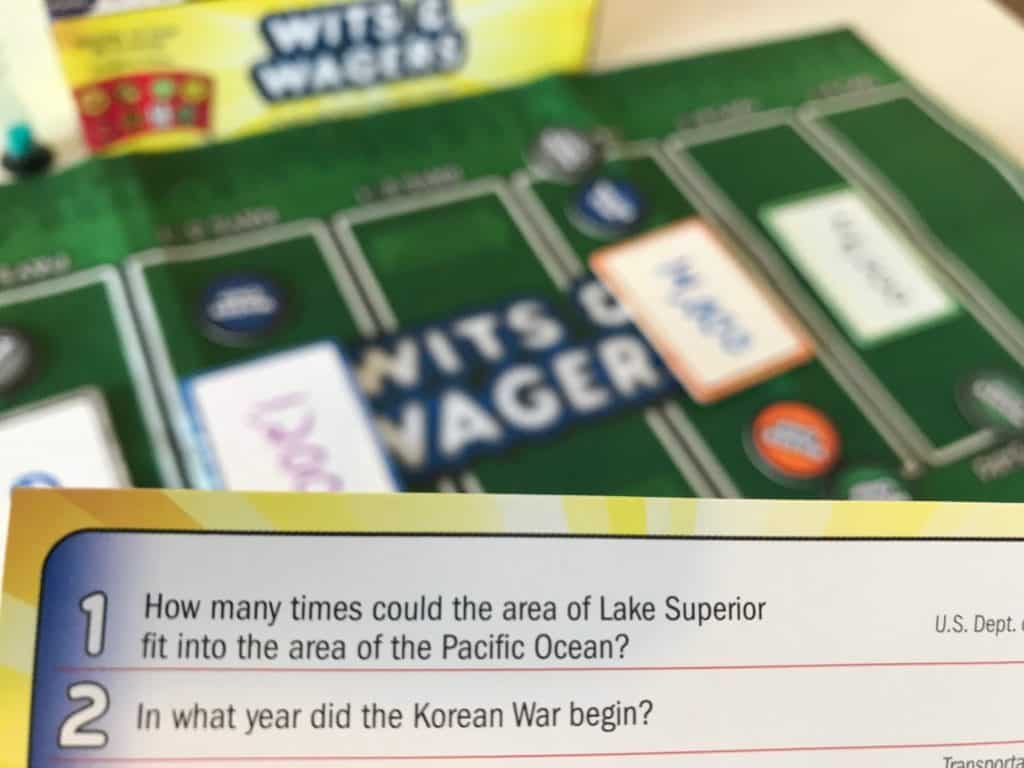
Specifications
| Players | Duration | Age | Type | Difficulty | Price |
| 2-7 | 30 minutes | 10+ | Trivia, Party | Very Easy | $25-$30 |
How it plays
Wits and Wagers is a trivia game with an awesome twist! Through seven rounds, players respond to random, off-the-wall quantitative questions. They write their answers on tiny dry erase boards and put them face down in the center of the table. Once all have answered, boards are turned over and the answers are lined up from smallest to biggest. Players then use chips to bet which answers they think are the closest. The player to have the most chips at the end of the seven rounds wins the game.
Why it’s good for non-game players
What makes Wits and Wagers so perfect for non-game players is that the questions are completely random. For most of them, no one knows the answers. Some players can find themselves in the ballpark of the right answer, but that’s usuallyas close as they get. And that’s perfect because it takes the pressure off players to do well and just lets them relax and have fun. This can pull down the barrier for some people and get them to play.
Another reason Wits and Wagers is great is that it takes a trivia game and makes it fun. Some people don’t mind playing trivia games, while others detest them because these games usually don’t have any real mechanics other than answering questions and moving a pawn across some bland game board. Wits and Wagers fixes this by taking a trivia game and melding it perfectly with an actual game that has content. Players make bets and win money.
Perhaps the most compelling reason that Wits and Wagers makes for a great game for everyone is that it’s so easy. This seems to be a recurring element on this list, and that’s probably for a good reason. Most people that don’t like to play board games, don’t like the complexity or complication of learning rules. Games like Wits and Wagers are extremely simple and can be taught while the first round is being played.
8) Chameleon
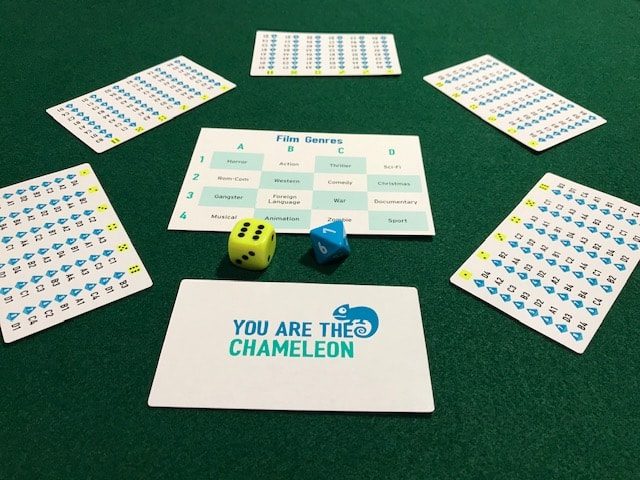
Specifications
| Players | Duration | Age | Type | Difficulty | Price |
| 3-8 | 5-10 minutes | 14+ | Bluffing, Party | Very easy | $20 |
How it plays
Chameleon is a great social deduction party game for 3-8 players. At the beginning of the game, each player is given a card that either has a code on it that will identify what the secret topic is or they will be given a card that identifies him or her as the Chameleon. Only one will be given the Chameleon card, while all others are given the secret topic. When everyone is ready, they each quickly give a one-word clue that expresses their knowledge of the topic, while not giving away what that topic is.
The Chameleon doesn’t know the topic, and therefore, must give a clue that will help them blend in and not be detected. After clues are given, the debate begins. All players vote on who they think the Chameleon is, and the player that receives the most votes must reveal his or her card. If the Chameleon goes undetected he wins. If he is voted on, everyone else wins.
Why it’s good for non-game players
One thing I’ve seen as I’ve played games with many people, is that some people like bluffing games, even when they don’t like other types of board games. And Chameleon is exactly that. For those that really enjoy lying games, or hate them less than others, this is the perfect game to get them to play. It should be noted, however, that some people specifically dislike bluffing-type games. So this game might be just the right one for some people, and the wrong one for others.
Perhaps the most compelling thing about Chameleon is that it plays very quickly! It’s by far the fastest game on this list. The cards are passed out, everyone gives a clue and then the group discusses who the Chameleon is. This can all happen in less than 5 minutes, though it usually takes around 10 minutes. But that’s it; there’s nothing more to it. People can be convinced easily to play because there is almost no time commitment at all.
9) Double Ditto
Specifications
| Players | Duration | Age | Type | Difficulty | Price |
| 4-99 | 20-30 minutes | 10+ | Party, word | Very Easy | $20 |
How it plays
Double Ditto is an awesome party game for any number of players. In this game, players all hold a card that has a number of boxes used in each round. Each player takes a turn drawing a card from the middle that contains broad category that will be used. Players have 15 seconds to write down two words that come to mind about that topic. For example, if the topic is delicious fruits, a person might write down watermelon and strawberries.
After everyone has written their words down they all compare their words with everyone else. Having a matching word (variations of the same word count) earns a player one point; having two matching words earns a player 3 points. The player with the most points, after each player has chosen a topic, wins.
Why it’s good for non-game players
This is one of the best games to get everyone to play because it’s a very low-key game. No, it’s an extremely low-key game. Most of the time that we play this game, everyone just sits around the room in various areas with a pen, a pencil and something to write on. Then, while everyone is relaxed, weplay. Most people are willing to play it for this reason.
Another reason this game is so great is that there isn’t a ton of structure. A card is read and everyone writes two words that come to mind. Then they just wait for everyone to finish. Though there is technically a 15 second time limit, we never play with it. It doesn’t usually take anyone much longer than 15 seconds anyway. Then everyone compares their answers with everyone else’s. It’s usually just a big conversation, with a game kind of happening too. Which makes it really easy to get everyone playing.
Another reason this game is perfect for those stubborn loved ones is that it can really be played for any length of time. The rule is that each player takes a turn reading a topic card from the middle, but that isn’t necessarily required. Like most games, this one can be adapted to the group that is playing it. If the group just wants to play a few rounds, there’s no reason that can’t be done. So shortening it for those that have short game attention spans is easy.
10) One Night: Ultimate Werewolf
Specifications
| Players | Duration | Age | Type | Difficulty | Price |
| 3-10 | 10 minutes | 8+ | Party, Bluffing | Easy | $15 |
How it plays
One Night: Ultimate Werewolf is essentially a simplified and more complicated variation of Mafia that we all grew up playing. It is more simple because it only has one night and one day. But it is more complicated because it has more characters with more abilities. The goal of the game is for the villagers to identify and get rid of the werewolves and it’s the werewolves’ job to remain undetected. During the night, all the characters perform their special abilities, if they have one. Then the town wakes up and accusations start flying. The game ends by a vote of who everyone thinks the werewolves are. The entire process usually takes 5-10 minutes, which makes for a quick, fun game.
Why it’s good for non-game players
This game is great because most people that I’ve met don’t hate playing Mafia. And One Night: Ultimate Werewolf is basically Mafia in boxed up form. Obviously, there are some differences between the two, but any of the changes are probably for the better. The obvious big difference is that it’s, you guessed it, only one night. Where the traditional Mafia game has multiple nights.
As you probably guessed, having more than one “night” in the game causes the game to last longer. Though it’s not necessarily a long game, it can take longer than it should. Going through the process of having the town go to sleep multiple times can make it feel like the game is dragging on. One Night solves this problem by having the town go to sleep just once. Then the debate begins. For those that would prefer to play quick games, this is the right one.
11) Telestrations
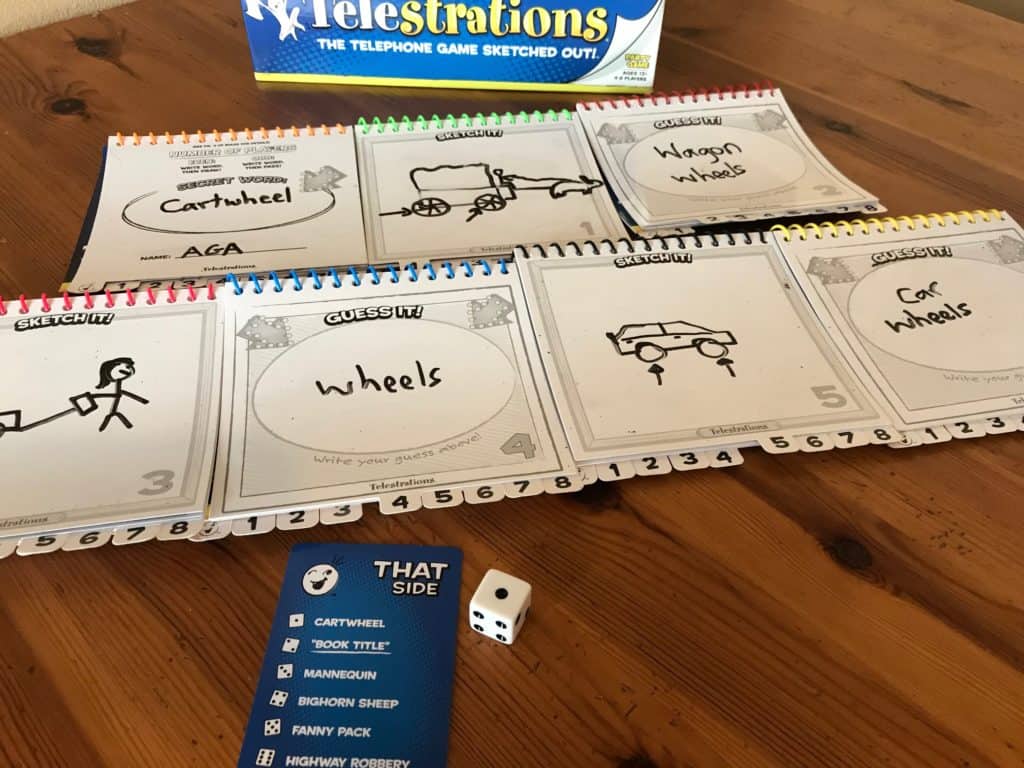
Specifications
| Players | Duration | Age | Type | Difficulty | Price |
| 4-8 | 30 minutes | 12+ | Party | Very easy | $20-$25 |
How it plays
Telestrations is basically the written version of telephone. InTtelestrations, each player has a dry-erase booklet made up of several pages. Each player is given a topic they must draw on page one. Once drawn, players hand their booklet to the person sitting next to them and receive the booklet from the player on the other side. It is then their turn to decipher what the previous player drew. That player writes what they determine is drawn in the booklet. The next player to receive the booklet has to draw whatever the previous player wrote down. This process continues until the last player receives and interprets the last drawing.
Obviously, for an easy topic, the same picture might be drawn each time and each guesser knows exactly what was drawn. For more abstract or complicated topics, it’s not so easy. Often the topic transforms and eventually bears no resemblance to its original form. That’s where it gets fun.
Why it’s good for non-game players
This is the perfect game for non-gamers because it doesn’t feel like a board game at all. It just feels like a bunch of people comically drawing fun pictures. We have had great success getting people to play this game, when they wouldn’t play any other game.
This is yet another game on this list that is so great because it just makes everyone laugh and have a good time. No one is really looking to be better than everyone else; instead, they are relaxed and ready to see what comes out on the other side of the round. One thing to note, though, is that if people are self conscious of their drawing abilities, this might not be the game to play. Though most people aren’t artists, and the drawings are pretty rough, some people don’t enjoy this game because they are especially concerned about how poorly they draw. If this is the case, another game on this list would be a better option.
Similarly to the fact that everyone is usually just playing to have fun, is that there isn’t really a way to win. Yes, you can get your topic to make it through all the phases without suffering through the metamorphosis that others experience, but that’s half the fun. If every topic made it through unchanged, there wouldn’t really be a game to play. So winning just isn’t a thing anyone is worried about with this game. So fun is the main objective.
Conclusion
We hope that this list was useful to you on your quest to get those that don’t usually like playing games to not only play, but enjoy themselves in the process. Obviously, there are many more games that could have been added to this list, but we had to stop somewhere. For a full list of games that we recommend check out our resources page by clicking here or navigate there through the menu.
